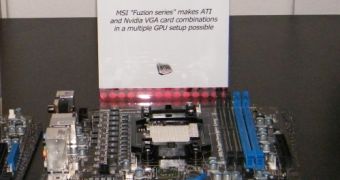Consumers even remotely interested in multi-GPU configurations must have at least heard of the Hydra 200 SoC (system-on-chip). This chip can allow a motherboard to use, jointly, any combination of graphics cards, regardless of model or manufacturer. Unsurprisingly, it was the possibility of combining AMD and NVIDIA cards that gave MSI's Big Bang Fuzion its success and, now, that success is ready to spawn several newer and much more affordable motherboards.
At the pre-Computex presentation, MSI was present with a whole array of devices, some of which were mainboards that seek to let mainstream users, and even those from the value segment, set up unrestricted multi-GPU scenarios. Three in number, the SKUs, while not made official yet, will use the aforementioned Hydra 200, which has two full PCI Express x16 slots.
One of the products runs on the AMD 870+SB850 chipset combination and boasts DrMOS, SATA3 (SATA 6.0Gbps) and USB 3.0 connectivity. The other one is powered by the Intel P55 chipset and has similar features. This duo will address the needs of the mid-end market segment and have estimated price tags of 139 Euro and 159 Euro, respectively. Quite reasonable for such mainboards, especially considering that the driver, which gives support for DirectX 11 on AMD-NVIDIA setups already exists, and supposedly runs better than SLI/CrossFireX in some instances. Nevertheless, for all their advantages, it is the value SKU that is more noteworthy.
The last of the trio is an AMD 870+SB710 platform. The most surprising part about this product is that, while costing the measly sum of 129 Euro, it still provides SATA3 and USB 3.0 connectivity. There is also the possibility of the final price tags, for all three boards, to end up lower than these estimates. More information should surface at Computex, so consumers will just have to wait about a week.

 14 DAY TRIAL //
14 DAY TRIAL //